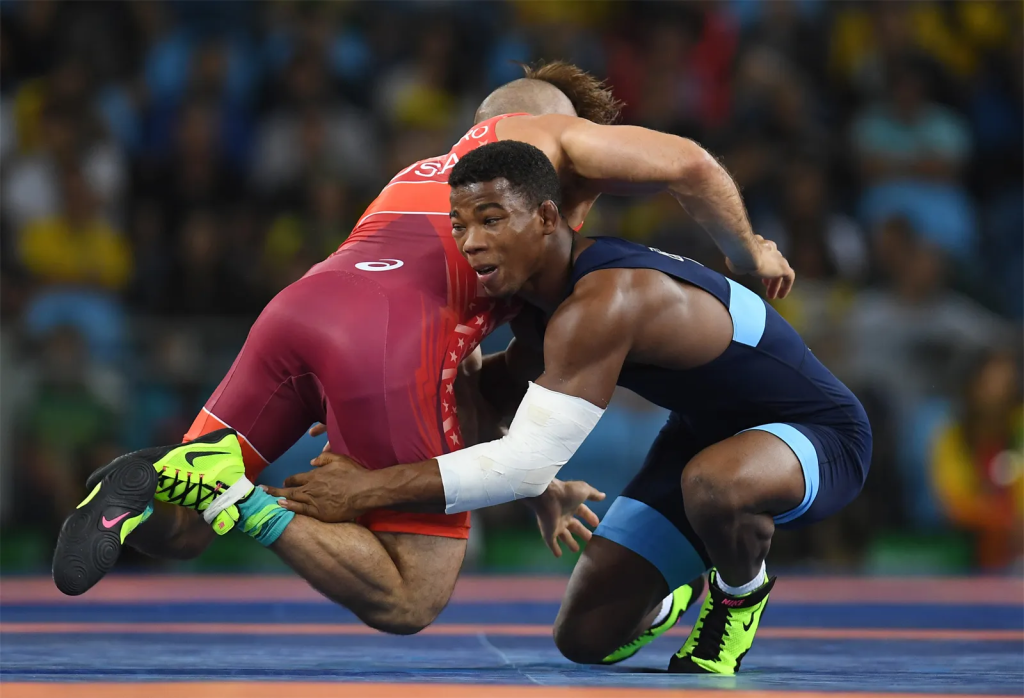27 de May de 2025
Wrestling Strength and Conditioning Program
Wrestling is a high-intensity combat sport requiring a fusion of strength, power, endurance, and technical prowess. Matches can be explosive and brief, or they can become prolonged battles of attrition — either way, wrestlers must prepare for all scenarios. Although technique and mat awareness are paramount, a specialized strength and conditioning (S&C) program ensures you remain strong in the clinch, powerful off the whistle, and resilient deep into the final period.
Below, we outline a comprehensive approach to wrestling-specific S&C, combining fundamental weight training principles with conditioning methods that emulate the dynamic demands of the sport.

Why Strength and Conditioning Matters for Wrestlers
- Explosive Power: A strong and fast takedown can tilt a match in your favor before your opponent even reacts. Training for power builds the capacity to shoot quickly, lift opponents off the mat, and sprawl with authority.
- Muscular Endurance: Wrestling matches tax both aerobic and anaerobic systems. Sustained isometric holds and repeated explosive movements demand well-rounded endurance.
- Grit and Mental Toughness: Hard workouts that mirror match intensity condition the mind as much as the body, building resilience and confidence when under pressure.
- Injury Prevention: Strengthening joints, improving flexibility, and practicing movement quality reduce the risk of common wrestling injuries, such as knee sprains, shoulder strains, and muscle pulls.
- Weight Management: A deliberate strength and conditioning program, combined with proper nutrition, helps wrestlers meet their weight-class goals without sacrificing performance.
Key Physical Qualities for Wrestling
- Maximal Strength: Forms the foundation of all other abilities. Squats, deadlifts, and heavy presses enable forceful ties, lifts, and slams.
- Explosive Power: Olympic variations (cleans, snatches) and plyometrics (box jumps, broad jumps) create speed-strength for aggressive takedowns.
- Muscular Endurance: Extended holds on the mat, repeated shots, and scramble situations require training that combines strength and aerobic capacity.
- Grip and Isometric Strength: Controlling wrists, clinches, and collar ties is often about outlasting the opponent in “grip battles.” Farmer’s carries, rope climbs, and heavy holds are staples.
- Flexibility and Mobility: Twisting out of holds or bridging to avoid back exposure demands a wide range of motion in the hips, shoulders, and spine.

Periodizing a Wrestling S&C Program
Like other combat sports, wrestling training is cyclical, with off-season, pre-season, and in-season phases. A well-structured S&C plan should:
- Off-Season (8–12 Weeks)
- Focus: Build base strength, correct imbalances, and develop aerobic capacity.
- Key Components:
- Heavy lifts (squats, deadlifts, bench presses) at moderate volumes.
- Steady-state cardio (running, swimming) for low-impact aerobic work.
- Unilateral and core exercises (lunges, plank variations) to fix weaknesses.
- Heavy lifts (squats, deadlifts, bench presses) at moderate volumes.
- Focus: Build base strength, correct imbalances, and develop aerobic capacity.
- Pre-Season (4–8 Weeks)
- Focus: Develop explosive power, anaerobic conditioning, and moderate-intensity technique sessions.
- Key Components:
- Olympic derivatives (hang cleans, power snatches).
- High-intensity interval training (HIIT) or circuit workouts simulating wrestling match intervals.
- Position-specific drills (partner carries, takedown circuits) to marry strength with mat skills.
- Olympic derivatives (hang cleans, power snatches).
- Focus: Develop explosive power, anaerobic conditioning, and moderate-intensity technique sessions.
- In-Season (12+ Weeks)
- Focus: Maintain strength, minimize fatigue, and refine sport-specific stamina.
- Key Components:
- Reduced-volume strength sessions (1–2 per week) at moderate intensities.
- Short, intense conditioning bouts (sprint intervals, agility ladder) for explosive readiness.
- Recovery emphasis (mobility, lower-intensity drilling) to stay fresh for meets and tournaments.
- Reduced-volume strength sessions (1–2 per week) at moderate intensities.
- Focus: Maintain strength, minimize fatigue, and refine sport-specific stamina.
Sample Weekly Wrestling S&C Framework (Pre-Season)
Day 1: Strength + Power
- Back Squats: 4×5 @ ~80% 1RM
- Hang Cleans: 4×3 focusing on bar speed
- Farmer’s Carries: 3× 30s heavy load
- Core Circuit (Planks, Toe Touches, Side Bends): 3×12
Day 2: Technical Practice
- Takedown Drills, Live Wrestling Rounds, Low-Volume Conditioning (light jog or footwork drills)
Day 3: Power-Endurance Circuit
- Tabata-Style Work (20s on/10s off for 8 rounds each):
- Kettlebell Swings
- Battle Ropes
- Rope Pull-Ups or “Gi Pull-Ups”
- Kettlebell Swings
- Med Ball Slams: 3×10
- Cooldown with Mobility Focus
Day 4: Technical Practice
- Position-Specific Sparring (front headlock, top/bottom), Speed Drills
Day 5: Strength Maintenance
- Deadlifts: 4×5 @ ~75% 1RM
- Bench Press: 4×6
- Pull-Ups: 3×Max
- Grip Work (Towel Pull-Ups, Plate Pinch): 2×Failure
Weekend
- Active Recovery (light jog, swimming, yoga) or Rest Day

Conditioning for Wrestling
- Interval Runs: Work-to-rest ratios of 1:1 or 2:1 mimic match-like intensities (e.g., 30s sprint, 30s rest, repeated).
- Grapple Circuits: Combine a lift (like power cleans) with a wrestling-related movement (like partner drags) for timed intervals.
- Live Situation Drills: Round-based, high-intensity scenarios (e.g., 2-minute takedown scrambles) to replicate match adrenaline.
- Bodyweight Complexes: Burpees, push-ups, sprawls, and mountain climbers in sequence for endurance under fatigue.

Strength & Conditioning Program
Leveraging Velocity Based Training (VBT)
A wrestling-focused S&C program can benefit from Velocity Based Training to tailor load prescriptions and monitor training quality:
- Daily Readiness: Attaching a VBT device to the bar provides real-time feedback on speed. If velocity at a known load is unusually low, you may reduce intensity or volume to manage fatigue.
- Load Velocity Profiling: Mapping how bar speed correlates with specific weights helps set precise percentages for strength or power days.
- Velocity Zones for Explosiveness: Training cleans or jumps in the correct velocity zone ensures you’re truly working on speed-strength and not just moving slowly.
- Monitoring Fatigue: Once velocity loss goes beyond a certain point, it signals excessive fatigue — time to cut the set or lighten the load to preserve quality.
Practical Tips for Wrestling Coaches
- Balance Volume: Most wrestlers have demanding practice schedules that already push cardiovascular capacity. Ensure your S&C plan enhances rather than overwhelms.
- Align with Technique Work: On days with tough sparring, keep strength sessions shorter and more maintenance-focused.
- Emphasize Recovery: Ample sleep, mobility sessions, hydration, and nutrient-dense meals will determine whether your training adaptions stick or lead to burnout.
- Skill over Ego: Flawless lifting technique and consistent progress matter more than chasing 1RM PRs every week. A stable, incremental approach yields better results over the season.
- Customize: Every wrestler is unique. Adjust sets, reps, intensity, or rest intervals based on experience level, weight class, and match schedule.
Conclusion
A well-rounded wrestling strength and conditioning program goes beyond raw power; it merges explosive lifts, targeted conditioning, and grip endurance into a seamless system that transfers directly to the mat. Whether you’re building your base in the off-season or refining your speed and technique in the heat of competition, systematic training — supported by tools like Velocity Based Training — sets you up to dominate every scramble, hold strong through each period, and secure more pins or points when it counts.
Ultimately, wrestling success hinges on bridging athleticism and skill with unwavering mental tenacity. By optimizing your S&C routine with the principles outlined here, you’ll remain confident in any position, any period, against any opponent.
